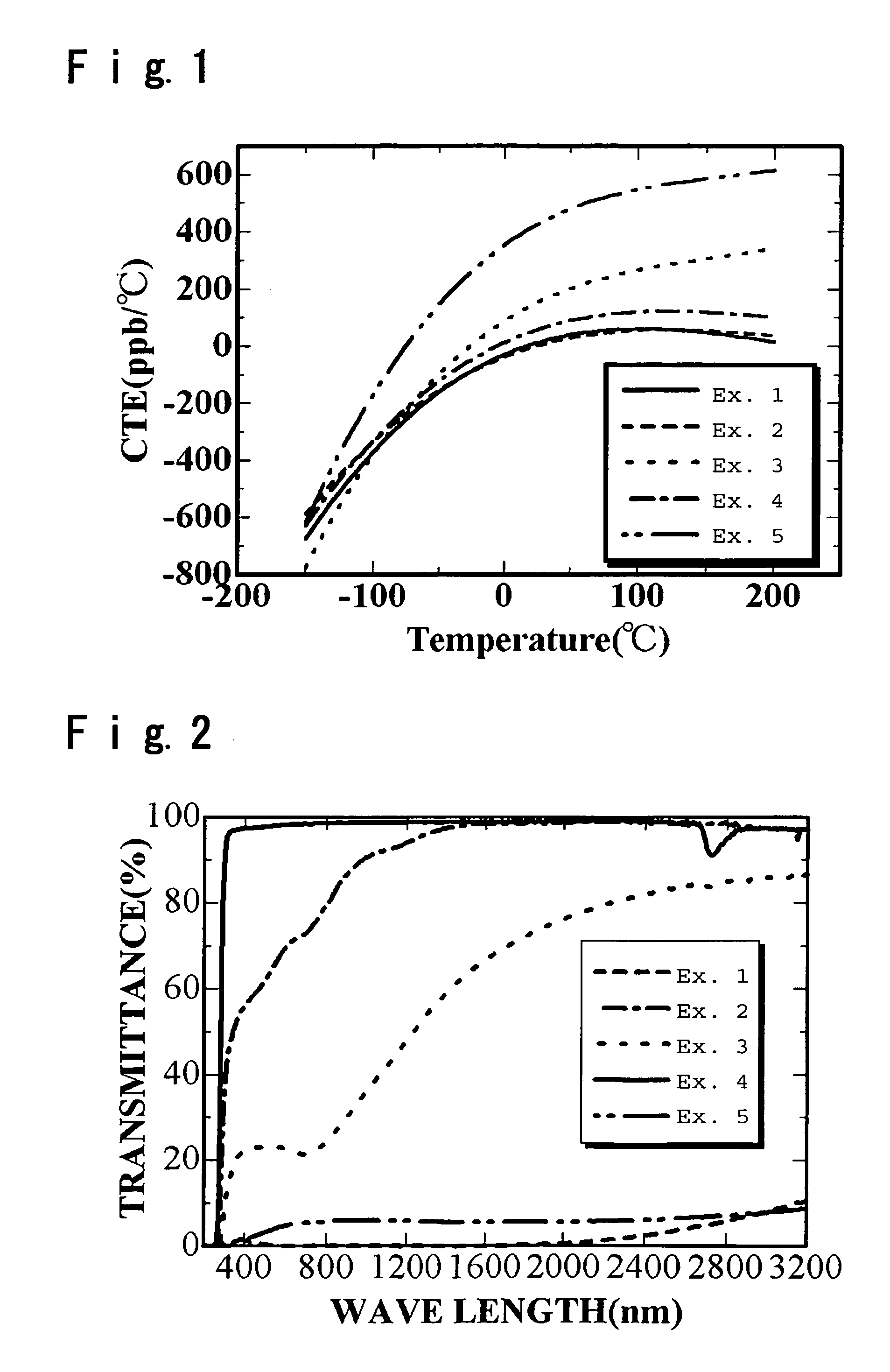Silica glass
- Summary
- Abstract
- Description
- Claims
- Application Information
AI Technical Summary
Benefits of technology
Problems solved by technology
Method used
Image
Examples
example 1
[0064] TiO2—SiO2 glass particles obtained by gasifying TiCl4 and SiCl4 as glass-forming materials for TiO2—SiO2 glass, respectively, then mixing them and feeding them to heat hydrolysis (flame hydrolysis) in oxyhydrogen flame, were deposited and grown on a target to form a porous TiO2—SiO2 glass body having a diameter of 80 cm and a length of about 100 cm (step (a)).
[0065] The obtained porous TiO2—SiO2 glass body was difficult to handle by itself, and therefore, as it was deposited on the target, it was held at 1,200° C. in the air for 4 hours and then removed from the target.
[0066] Then, the porous TiO2—SiO2 glass body was set in an electric furnace capable of controlling the atmosphere, and after reducing the pressure to 1,330 Pa at room temperature, returned to atmospheric pressure by a mixed gas of He / SiF4=90 / 10 (volume ratio) and held at room temperature for two hours under the He / SiF4=90 / 10 (volume ratio) gas atmosphere (step (b)).
[0067] Then, it was heated to 1,570° C. in ...
example 2
[0069] TiO2—SiO2 glass particles obtained by gasifying TiCl4 and SiCl4 as glass-forming materials for TiO2—SiO2 glass, respectively, then mixing them and feeding them to heat hydrolysis (flame hydrolysis) in oxyhydrogen flame, were deposited and grown on a target to form a porous TiO2—SiO2 glass body having a diameter of 80 cm and a length of about 100 cm (step (a)).
[0070] The obtained porous TiO2—SiO2 glass body was difficult to handle by itself, and therefore, as it was deposited on the target, it was held at 1,200° C. in the air for 4 hours and then removed from the target.
[0071] Then, the porous TiO2—SiO2 glass body was set in an electric furnace capable of controlling the atmosphere, and after reducing the pressure to 1,330 Pa at room temperature, returned to atmospheric pressure by a mixed gas of O2 / SiF4=90 / 10 (volume ratio) and heated at 1,000° C. for four hours under the O2 / SiF4=90 / 10 (volume ratio) gas atmosphere (step (b)).
[0072] Then, it was heated to 1,540° C. in an a...
example 3
[0074] TiO2—SiO2 glass particles obtained by gasifying TiCl4 and SiCl4 as glass-forming materials for TiO2—SiO2 glass, respectively, then mixing them and feeding them to heat hydrolysis (flame hydrolysis) in oxyhydrogen flame, were deposited and grown on a target to form a porous TiO2—SiO2 glass body having a diameter of 80 cm and a length of about 100 cm (step (a)).
[0075] The obtained porous TiO2—SiO2 glass body was difficult to handle by itself, and therefore, as it was deposited on the target, it was held at 1,200° C. in the air for 4 hours and then removed from the target.
[0076] Then, the porous TiO2—SiO2 glass body was set in a carbon electric resistance furnace, and after reducing the pressure to 1,330 Pa at room temperature, heated to 1,400° C. and held at this temperature for 4 hours. Further, it was continuously heated to 1,570° C. in an atmosphere of 100% He and then, held at this temperature for 4 hours to obtain a TiO2—SiO2 glass body (step (c′)).
[0077] The obtained g...
PUM
| Property | Measurement | Unit |
|---|---|---|
| Temperature | aaaaa | aaaaa |
| Percent by mass | aaaaa | aaaaa |
| Thickness | aaaaa | aaaaa |
Abstract
Description
Claims
Application Information
 Login to View More
Login to View More - R&D
- Intellectual Property
- Life Sciences
- Materials
- Tech Scout
- Unparalleled Data Quality
- Higher Quality Content
- 60% Fewer Hallucinations
Browse by: Latest US Patents, China's latest patents, Technical Efficacy Thesaurus, Application Domain, Technology Topic, Popular Technical Reports.
© 2025 PatSnap. All rights reserved.Legal|Privacy policy|Modern Slavery Act Transparency Statement|Sitemap|About US| Contact US: help@patsnap.com

